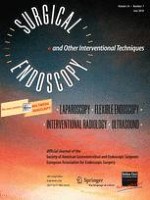Published in:

01-07-2010
Is unilateral laparoscopic TEP inguinal hernia repair a job half done? The case for bilateral repair
Authors:
Pawanindra Lal, Prejesh Philips, Jagdish Chander, Vinod K. Ramteke
Published in:
Surgical Endoscopy
|
Issue 7/2010
Login to get access
Abstract
Introduction
Bilateral laparoscopic totally extraperitoneal (TEP) repair of unilateral hernia is conspicuous in published literature by its absence. There are no studies or data on the feasibility, advantages or disadvantages of bilateral repair in all cases or in any subset of patients with unilateral primary inguinal hernia. The objective of this study is to investigate the feasibility of bilateral laparoscopic exploration for all unilateral cases followed by laparoscopic TEP in all cases and to compare complications, recurrence rates, postoperative pain, patient satisfaction, and return to work retrospectively with a similar number of age-matched retrospective controls.
Method
One hundred fifty TEP operations were performed in 75 patients (group A) prospectively and were compared with 75 unilateral TEP operations (group B) in age-matched controls done previously by the same surgeon. All cases were performed under general anesthesia, and TEP repair was performed using three midline ports. All uncomplicated patients were discharged at 24 h, in keeping with departmental policy.
Results
Of 75 patients (group A), 25 (33.3%) were clinically diagnosed with bilateral hernia and the rest (50, 66.66%) with unilateral hernia. The distribution of the 25 bilateral cases was 11 bilateral direct and 14 bilateral indirect inguinal hernias. The distribution of the 75 age-matched controls (group B) was all unilateral hernia, of which 47 were right-sided and 28 were left-sided. There were 23 direct hernias and 52 indirect hernias among the control group. The mean operative time for all 150 cases was 76.66 ± 15.92 min. The operative time in the control group (unilateral hernias) was 66.16 ± 12.44 min, whereas the operative time in the test group (bilateral repair) was 87.2 ± 11.32 min. The operative time in the bilateral group was significantly higher, by 21.04 min or 31.88% (p = 0.000). The operative time in the true unilateral group was 82.45 ± 9.38 min, whereas the operative time in the former group [occult contralateral hernias (OCHs) + bilateral hernias] was 91.35 ± 11.95 min, which is a statistically significant difference (p = 0.0015). Occult hernia was seen in a total of 15 cases, of which 13 were OCHs (26%) and 2 were occult ipsilateral hernias (OIH). The mean operative time in the OCH cases was 81.46 ± 7.9 min, whereas in those without OCH it was 82.45 ± 9.38 min, which is not a statistically significant difference (p = 0.46). Regarding complications, there were no cases of seroma, hematoma, wound infection, visceral injury or postoperative neuralgia in either group A or B. On statistical analysis, visual analog score (VAS)-measured pain score, at 12 h only, was significantly higher in the unilateral repair group as compared with the bilateral TEP group; VAS scores at all other times were not statistically significantly different between the two groups. The average time of return to light routine or activities of daily living was 1 day in group A, whereas in group B it was 1.91 days (range 1–3 days), which is a statistically significant difference (p = 0.000). There was one case of recurrence in this study, in a left-sided hernia in group A, over a follow-up period of 60–72 (mean 66) months; all patients reported for follow-up by office visit or correspondence until 2 years, and two patients were lost to follow-up after 2 years. In group B, there was no recurrence over a follow-up period of 72–84 months, with three patients lost to follow-up after 3 years.
Conclusion
In the present study bilateral TEP was performed in three types of patients: those with clinically bilateral hernias, those with clinically unilateral hernia but with an OCH, and in truly unilateral hernias. All of these were compared with unilateral TEPs in clinically unilateral hernias, and we found no significant increase in morbidity, pain, recurrence or complications in bilateral repairs. Convalescence from surgery, as determined by return to activities of daily living and return to work parameters, was also comparable. Surgeons experienced in laparoscopic TEP, in high-volume centers, can provide bilateral repairs in patients with inguinal hernia, bearing in mind its advantages and comparable morbidity. We also feel that, in elective repair of inguinal hernia, the patient should be given the option of bilateral repair. Bilateral repair does not add to the risk of surgery in experienced hands and we strongly feel that unilateral TEP is actually a job half done.